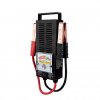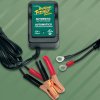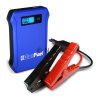Thanks everyone. This is very helpful. As usual, I'm getting my education on this thread.
Here in Nassau, I'd rather not try to find someone to help me do a proper load test, and would like to see if I can diagnose this on my own. Tonight, I will take Dennis's advice of charing the battery overnight with a known, trusted charger. But first, let me share this:
I just used my multimeter to measure the faulty battery at its terminals. I got 3.5V. Is that even salvageable? (I thought I once read that a discharged 12V battery shouldn't actually ever go below a certain point.) I then flipped the selector switch to "both", so that it was connected to the other starter, and of course the voltage jumped up to just over 12V. When I flipped the selector switch again, and held the multimeter to the faulty battery, I could see the 'surface charge' (if that's the right word) slowly dropping, as the voltage quickly ran down to the 4.5V range.
I can still try to trickle-charge it this weekend, to see if it takes a charge, but thought I'd ask whether the very low voltage was an indicator of anything.
If this battery is indeed dead, then my theory is that I killed it by treating it as a house battery. I mentioned in another thread that I recently discovered the PO had wired all electronics to this starter, rather than to the house battery. So, I have unknowingly drained this starter on several occassions, and I understand that this can be the kiss of death for starter batteries, since (as Seasick said) they aren't designed to trickle down so low.




